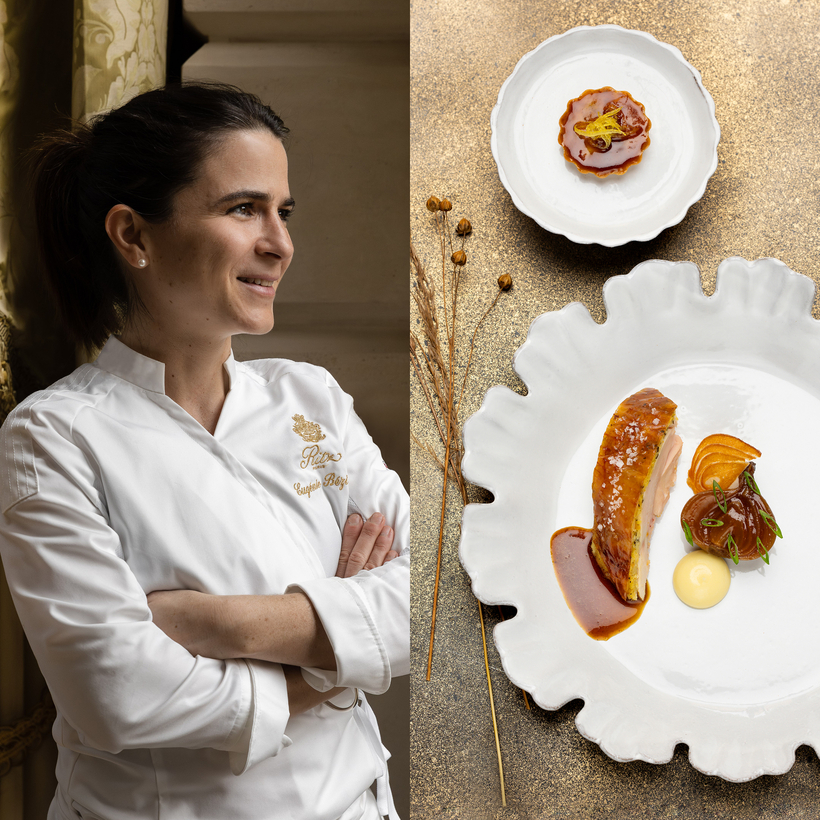Will Eugénie Béziat become the Coco Chanel of French gastronomy? The young French chef has taken over Espadon, the haute cuisine restaurant of the Hôtel Ritz in Paris, and even though it’s not opening until September 26, it’s all that anyone is talking about.
The kitchens of the Ritz have been an epicenter of gastronomy ever since hotelier César Ritz and chef Auguste Escoffier opened the property, in 1898. But L’Espadon, as the restaurant was then called, closed on March 14, 2020. When, in 2022, the hotel announced that the little-known Béziat had replaced outgoing chef Nicolas Sale, it was front-page news. (Well, at least in France.)

Béziat’s backstory is intriguing. Born in West Africa to French parents, she grew up in Gabon, Ivory Coast, and Congo. She was studying literature and language at a university in Toulouse when, thanks to her gourmet parents, she sampled oysters in green-apple gelée at Hélène Darroze’s restaurant in Paris. She was so overwhelmed by emotion that she decided to become a chef herself.
After graduating from hotel school in Toulouse, Beziat worked in the Michelin-starred kitchens of chefs Michel Guérard, at Les Prés d’Eugénie, and Michel Sarran, in Toulouse. Ultimately, she was recruited as head chef at La Flibuste in Villeneuve-Loubet, the hometown of Escoffier, which was given its own Michelin star in 2020.

Espadon has lived many lives, and I’ve been involved in all of them since 1986, when I moved to Paris. I was very curious to return, and, last week, I was among a small group of culinary types to taste Béziat’s new menu.
Walking down the Rue Cambon to Espadon on an Indian-summer night, I was struck by long-lost memories of the place. There were several torturous lunches with the sharp-tongued John Fairchild, who was my boss when I was an editor at Fairchild Publications, whose offices were nearby at the time. And then there was an unexpectedly flirtatious dinner with Hubert de Givenchy, which was interrupted when Lauren Bacall sat down at our table and ordered a cèpe omelet and a bottle of Meursault. “I hope you boys don’t mind if I join you,” she said with a throaty chuckle. She ate and drank quickly, and when she left, she smiled at me and said, “Don’t let your good manners ruin your life, sweetheart.”

In the 80s, L’Espadon operated as a club. Anyone staying solo at the Ritz would stick their head in the door to see who else was in town, and would usually end up being invited to dine with friends, new or old. All of this changed in 2016, when the restaurant migrated to a grander setting in the heart of the hotel; the beau monde never followed. Previously a Paris institution, L’Espadon gradually became nothing more than a very good but rather dull hotel restaurant.
Now the entrance to the beautifully lit dining room is a short hallway lined with porcelain bisque plaques that depict rhubarb leaves, which Escoffier loved. Inside, its tables—there are only 30 covers—are dressed in white linen and set with Astier de Villatte faience; the tin-glazed ceramic is a deliberate rupture with the formality of Limoges porcelain. But the primary decorative element is the kitchen, visible through thick-glass picture windows bordered in copper.

After some polite hors d’oeuvres, Béziat sent out a deeply braised tomato—a gastronomic grenade. Its head-spinning flavor was a shocking concentration of umami produced by the combination of the fruit’s natural sweetness and the acidity created by low-and-slow cooking. The five courses that followed made for an exquisitely elegant and intriguingly original meal. Fine seasonal produce, some of which was sourced from the Ritz’s vegetable garden in Versailles, was brightly embroidered with flavors of Béziat’s childhood in Africa as well as her parents’ roots in Calabria and Spain.
“Don’t let your good manners ruin your life, sweetheart.”
A plump, iodine-rich Spéciale Giol oyster from La-Seyne-sur-Mer was perfectly grilled to infuse it with smoke without its losing its fleshy succulence. A complex dish of artichokes, cocoa, and capers had the moody percussion of Miles Davis’s jazz. Béziat’s heirloom Houdan chicken with onions and lemon was an homage to chicken yassa, one of the most popular dishes in West Africa. In her version, onions baked in clay were presented and then cracked out of their shells to garnish the roast bird, which was carved tableside and served with a sublime, lemon-spiked jus.

The final dish before dessert was one the French might describe as déroutant, or unsettling. Grilled lobster-tail came in an astringent, vermillion pool of bissap, the hibiscus-flower juice popular in West Africa. A manioc-flour dumpling was served on the side. Leagues away from the reverent way this crustacean would normally be treated in a French kitchen, this tongue-in-cheek composition reprised the flavors of an African beach barbecue. Rather surprisingly, it seems that the Ritz management has decided to open a really interesting restaurant, rather than one that peddles caviar and truffles.
The next morning, I returned to the Ritz to meet Béziat in the Coco Chanel suite, which overlooks the Place Vendôme. “I reason like a perfumer,” said the poised, diminutive chef, who wore an all-black chef’s ensemble. “I compose a dish using different notes—some floral, like jasmine; some resinous, including rosemary; and others that are ambered, smoky, saline, earthy.... I am always working to find the equilibrium in every dish.” The eloquent way she talked about spices reminded me of Olivier Roellinger, who is equally passionate about them.

To prepare for the job, Béziat immersed herself in the life and times of Escoffier. “I was a bit like a detective, seeking to discover and inhabit his world,” she said. “For the future, I aspire to elegance and sensuality revealed by perfect details.”
If that sounds familiar, it’s because it could have been a quote from Chanel, who occupied a room at the Ritz for many years while she went about creating her legacy. No doubt Béziat seeks a similar staying power.
Alexander Lobrano is a Writer at Large at AIR MAIL. His latest book, the gastronomic coming-of-age story My Place at the Table: A Recipe for a Delicious Life in Paris, is out now


